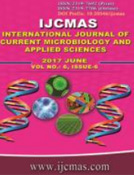


 National Academy of Agricultural Sciences (NAAS)
National Academy of Agricultural Sciences (NAAS)

|
PRINT ISSN : 2319-7692
Online ISSN : 2319-7706 Issues : 12 per year Publisher : Excellent Publishers Email : editorijcmas@gmail.com / submit@ijcmas.com Editor-in-chief: Dr.M.Prakash Index Copernicus ICV 2018: 95.39 NAAS RATING 2020: 5.38 |
The study was conducted to compare the effects of different plant products: Neem oil, NSKE, Karanj oil, Karanj seed powder extract, Chilli garlic solution, Chilli solution and Chlorantraniliprole on leaf folder’s population in a rice field at Research cum Instructional Farm, College of Agriculture, Indira Gandhi Krishi Vishwavidyalaya Raipur (C.G.) during Kharifseason 2015-16.Yield losses due to leaf folder is estimated 23-30 percent every year (Prakash et al.,, 2008). The experiment was laid in randomized block design (RBD) with three replicates. Biological insecticides including six botanical (Neem oil, NSKE, Karanj oil, Karanj seed powder extract, Chilli garlic solution, Chilli solution) and one insecticide (Chlorantraniliprole) were applied to the rice crop. The leaf folder’s population was counted one day before and after three, seven and fourteen days from treatment application. Chlorantraniliprole 18.5% SC showed least leaf damage per cent (1.10 mean leaf damage per cent on per five hills). Among different plant products, Karanj oil followed by Chilli garlic solution were found to be most effective treatments with minimum 2.26 and 2.45 mean leaf damage per cent and maximum 41.45 and 36.53 per cent reduction over control respectively. The findings on incremental cost benefit for different treatments revealed that the highest ICBR (1: 5.56) was obtained in the treatment of Chilli solution and it appeared as the most economically viable treatment. The treatment with spraying of Karanj oil was found to be the next profitable treatment providing the ICBR 1:5.32 followed by Neem oil (1:5.05).
 |
 |
 |
 |
 |